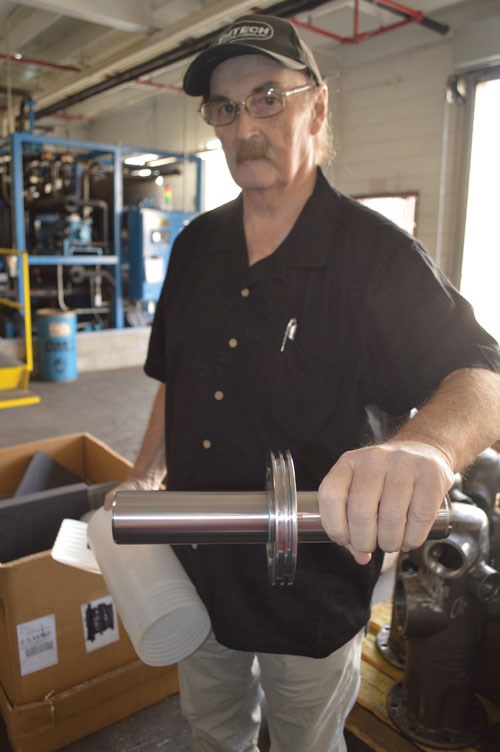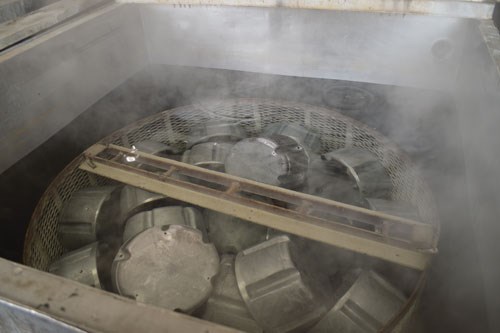Imtech Preaches Impregnation For Plated Parts
Peter Gebhard has a very practical way to explain the densification process in die casting.
Peter Gebhard has a very practical way to explain the densification process in die casting, and how it relates to porosity issues that affect surface finishing.
“Castings are taking a liquid and making it a solid, and that’s a densification process,” says Gebhard, owner of Imtech, a California impregnation company.
“The only thing that expands when it goes from a liquid to a solid is ice, and everything else shrinks and causes pores to develop. I like ice in my scotch and whiskey, but I don’t like it in my engine block,” he says. “Pores develop with the shrinking, and then you have a problem.”
And Gebhard knows a thing or two about porosity and impregnation, having been one of the pioneers in solving porosity problems in cast metals, powdered metals, electronic components and ceramic parts as previous owner of Rhode Island-based Impco Inc., which was purchased by Godfrey and Wing in 2014.

Ken Shonk, vice president at Imtech, shows a part that underwent impregnation.
Today, Gebhard and Ken Shonk, vice president at Imtech, preach the unique benefits of cleaning and impregnation to all who will listen. Their facility in Santa Fe Springs near Los Angeles has the process down to a science.
Gebhard, a Harvard University graduate with more than 40 years of experience in metal finishing works well with Shonk, who runs the shop’s day-to-day activities. Shonk was vice president of Crown City Plating in El Monte—once the largest plating operation in the U.S.—before the plant closed in 2005.
Shonk says once finishers understand the benefits and process of impregnation, they come to appreciate its usefulness.
“A lot of people just don’t know what the process can do for their part,” Shonk says. “Most manufacturers think finishing is dip and ship. It’s the same as cleaning, where you need good adhesion and appearance. These are critical steps to prevent failures.”
Imtech serves the aerospace, automotive, medical, instrumentation, construction equipment, appliances, tools and plumbing markets. The company touts its RC-80ND as a two-part thermo-setting resin designed for the impregnation of all types of micro- and macro-porous, ferrous and nonferrous alloy castings, as well as other metal and nonmetal parts.
“It’s resistant to fuels, oils, alcohols, glycols, solvents, salts, mild acids and freons,” Shonk says. “And it has very good dielectric properties; it is uninhibited by copper-based alloys.”
The basic process for cleaning and impregnation is simple:
Generally, the first step is cleaning in a vapor of perchlorethylene. Removing oils and especially water-based contaminants from both the part surface and the pores is critical to allow the impregnation materials to fully penetrate the porosity. With the largest commercial Serec airless degreasing system operating west of the Mississippi, Imtech has the capacity to clean and degrease parts 10 feet long and weighing over 1,000 pounds.
Parts are then put into an autoclave, where a vacuum is drawn; the air in the pores is evacuated without an impregnating liquid present so as not to impede the evacuation to a level of 15 to 35 torr.

Gebhard has a very practical way to explain the densification process in die casting.
Liquid impregnant is introduced while the parts are still under vacuum.
A pressure cycle of up to 80–90 psi of shop air pressure (or up to six atmospheres) forces the impregnant deep into the porous cavities of the part for more positive sealing.
The part is removed from the autoclave and the surface is rinsed in plain water.
Impregnation fills the pores that would otherwise entrap plating and anodizing solutions, ultimately causing bleed out or spotting on the plated and anodized surface. Sealing the pores also helps solve the pitting and bubbling found on painted or powder-coated surfaces. The same principle applies: If you clean and seal the underlying porosity, the surface finish will be better and more durable.
Machined surfaces or tolerances are not affected by impregnation, Shonk says, and the liquid material in the pores is cured by the application of heat.
Originally published in the August 2015 issue.
Related Content
Nanotechnology Start-up Develops Gold Plating Replacement
Ag-Nano System LLC introduces a new method of electroplating based on golden silver nanoparticles aimed at replacing gold plating used in electrical circuits.
Read MoreProducts Finishing Reveals 2024 Qualifying Top Shops
PF reveals the qualifying shops in its annual Top Shops Benchmarking Survey — a program designed to offer shops insights into their overall performance in the industry.
Read MorePossibilities From Electroplating 3D Printed Plastic Parts
Adding layers of nickel or copper to 3D printed polymer can impart desired properties such as electrical conductivity, EMI shielding, abrasion resistance and improved strength — approaching and even exceeding 3D printed metal, according to RePliForm.
Read MoreAn Overview of Electroless Nickel Plating
By definition, electroless plating is metal deposition by a controlled chemical reaction.
Read MoreRead Next
Delivering Increased Benefits to Greenhouse Films
Baystar's Borstar technology is helping customers deliver better, more reliable production methods to greenhouse agriculture.
Read MoreA ‘Clean’ Agenda Offers Unique Presentations in Chicago
The 2024 Parts Cleaning Conference, co-located with the International Manufacturing Technology Show, includes presentations by several speakers who are new to the conference and topics that have not been covered in past editions of this event.
Read MoreEpisode 45: An Interview with Chandler Mancuso, MacDermid Envio Solutions
Chandler Mancuso, technical director with MacDermid Envio discusses updating your wastewater treatment system and implementing materials recycling solutions to increase efficiencies, control costs and reduce environmental impact.
Read More





















